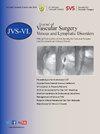Limb volumetry using an iPad-based three-dimensional scanner for assessment of edema
IF 2.8
2区 医学
Q2 PERIPHERAL VASCULAR DISEASE
Journal of vascular surgery. Venous and lymphatic disorders
Pub Date : 2025-06-06
DOI:10.1016/j.jvsv.2025.102275
引用次数: 0
Abstract
Objective
Quantifying limb edema is challenging owing to the lack of an easily accessible clinical technique. This study evaluates the reproducibility of an iPad-based three-dimensional (3D) scanning system for lower limb volumetry and identifies factors influencing measurement variability.
Methods
Twenty limbs from 10 healthy volunteers were scanned using an iPad-based Structure Sensor and software. Initial scans followed standard manufacturer instructions, but high variance rendered data unsuitable for clinical use. To improve accuracy, a standardized scanning protocol was developed, incorporating anatomical calibration, scanning distance standardization, and scanning time control. A 254-mm calf segment was defined using a 3D marker placed on the medial malleolus to ensure consistent volume measurement. The scanning distance was fixed between 50 and 59 cm to reduce zoom parallax errors, and scans were conducted after 3 pm to minimize diurnal volume fluctuations. Multiple technicians performed repeat scans on the same limb to assess intraobserver and interobserver scan reliability.
Results
Implementing the standardized protocol significantly decreased measurement variability. Defining a consistent anatomical scan region improved reproducibility, with the mean volume difference decreasing from 4.7% ± 3.6% to 2.1% ± 1.6%. Standardizing scanning distance reduced zoom-related errors, improving measurement consistency from 2.6% ± 1.5% to 2.0% ± 1.2% (P = .037). Time standardization further optimized accuracy, yielding a final mean volume difference of 1.8% ± 0.9%. No statistically significant differences were observed between measurements taken by different technicians (P > .05), demonstrating high interobserver reliability.
Conclusions
iPad-based 3D scanning provides a clinically reliable and cost-effective method of lower limb volumetry. The standardized protocol as described improves scan accuracy and reproducibility. Future studies should evaluate this method in a clinical population to validate its usefulness in disease assessment and progression tracking.
基于iPad的肢体体积三维扫描仪评估水肿。
目的:由于缺乏一种容易获得的临床技术,量化肢体水肿是具有挑战性的。本研究评估了基于ipad的下肢体积三维扫描系统的可重复性,并确定了影响测量变异性的因素。方法:采用基于ipad的结构传感器和软件对10名健康志愿者的20条肢体进行扫描。最初的扫描遵循标准的制造商说明,但高方差使得数据不适合临床使用。为了提高扫描精度,我们制定了一套标准化的扫描方案,包括解剖校准、扫描距离标准化和扫描时间控制。使用放置在内踝上的3D标记物定义254 mm小腿段,以确保体积测量一致。扫描距离固定在50-59 cm之间,以减少变焦视差误差,并在下午3点后进行扫描,以尽量减少日体积波动。多名技术人员对同一肢体进行重复扫描,以评估观察者内部和观察者之间的扫描可靠性。结果:标准化方案的实施显著降低了测量的可变性。定义一致的解剖扫描区域提高了再现性,平均体积差从4.7%±3.6%下降到2.1%±1.6%。标准化的扫描距离降低了变焦相关误差,将测量一致性从2.6%±1.5%提高到2.0%±1.2% (p = 0.037)。时间标准化进一步优化了准确度,最终平均体积差为1.8%±0.9%。不同技术人员的测量结果无统计学差异(p < 0.05),显示出较高的观察者间信度。结论:基于ipad的3D扫描为下肢体积测量提供了一种临床可靠且经济的方法。所描述的标准化协议提高了扫描精度和再现性。未来的研究应在临床人群中评估该方法,以验证其在疾病评估和进展跟踪方面的效用。
本文章由计算机程序翻译,如有差异,请以英文原文为准。
求助全文
约1分钟内获得全文
求助全文
来源期刊

Journal of vascular surgery. Venous and lymphatic disorders
SURGERYPERIPHERAL VASCULAR DISEASE&n-PERIPHERAL VASCULAR DISEASE
CiteScore
6.30
自引率
18.80%
发文量
328
审稿时长
71 days
期刊介绍:
Journal of Vascular Surgery: Venous and Lymphatic Disorders is one of a series of specialist journals launched by the Journal of Vascular Surgery. It aims to be the premier international Journal of medical, endovascular and surgical management of venous and lymphatic disorders. It publishes high quality clinical, research, case reports, techniques, and practice manuscripts related to all aspects of venous and lymphatic disorders, including malformations and wound care, with an emphasis on the practicing clinician. The journal seeks to provide novel and timely information to vascular surgeons, interventionalists, phlebologists, wound care specialists, and allied health professionals who treat patients presenting with vascular and lymphatic disorders. As the official publication of The Society for Vascular Surgery and the American Venous Forum, the Journal will publish, after peer review, selected papers presented at the annual meeting of these organizations and affiliated vascular societies, as well as original articles from members and non-members.
 求助内容:
求助内容: 应助结果提醒方式:
应助结果提醒方式:


